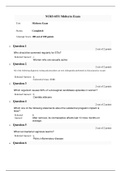Exam (elaborations)
NURS 6551 Midterm Exam (3 Versions, 150 Q & A ) / NURS6551N Midterm Exam ( Year-2019/2020, Verified and 100% Correct Answers)
- Course
- Institution
NURS 6551 Midterm Exam / NURS6551 Midterm Exam (Latest): Primary Care of Women: Walden University Walden University NURS 6551 Midterm Exam / Walden University NURS6551 Midterm Exam Question 1 How can liver and renal diseases result in abnormal uterine bleeding (AUB)? a. They cause an imbalance in...
[Show more]



